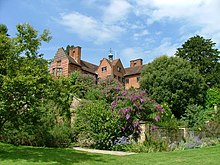Philip Tilden
| Philip Tilden | |
|---|---|

Chartwell, Winston Churchill's country home, largely re-designed by Tilden
|
|
| Born | 31 May 1887 |
| Died | 25 February 1956 |
| Nationality | British |
| Occupation | Architect |
| Buildings | Chartwell, Port Lympne Mansion, Bron-y-De, Churt |
Philip Tilden (31 May 1887 – 25 February 1956) was an English architect, active in the early twentieth century, who worked for some of the most prominent members of English society, including Winston Churchill, David Lloyd George, Lord Beaverbrook, Sir Philip Sassoon, Lady Ottoline Morrell and Gordon Selfridge.
Tilden was born on 31 May 1887, the son of William Augustus Tilden, a prominent chemist who discovered synthetic rubber. Educated at Bedales and Rugby, Tilden joined the Architectural Association in 1905, leaving in 1908 to become an articled pupil to Thomas Edward Collcutt, with whom he later went into partnership. By 1917, he had established his own practice and for the next twenty years worked almost exclusively for a small circle of rich, interconnected, patrons for whom he designed, or re-constructed, country houses, gardens, chapels and churches, castles and a vast tower that was intended to sit on top of Gordon Selfridge's department store on Oxford Street, London.
His best known works, apart from the unexecuted design for the Selfridges tower, were all for politicians: from 1918 to 1923 he designed the Moorish Courtyard, compared by Honor Channon to a "Spanish brothel", and the gardens and swimming pools at Port Lympne for Lloyd George's secretary, Philip Sassoon and may also have worked for Sassoon at Trent Park. Later in 1920s he completely reconstructed Chartwell Manor for Winston Churchill and during the same period built Bron-y-de, at Churt in Surrey, as a country house for David Lloyd George.
...
Wikipedia
